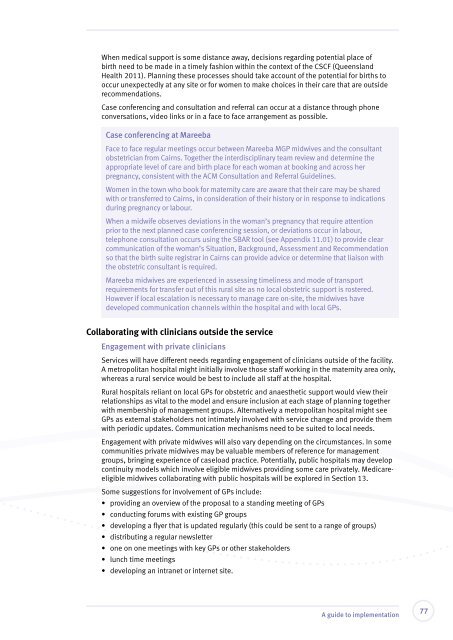Delivering continuity of midwifery care to Queensland women
Delivering continuity of midwifery care to Queensland women
Delivering continuity of midwifery care to Queensland women
You also want an ePaper? Increase the reach of your titles
YUMPU automatically turns print PDFs into web optimized ePapers that Google loves.
When medical support is some distance away, decisions regarding potential place <strong>of</strong><br />
birth need <strong>to</strong> be made in a timely fashion within the context <strong>of</strong> the CSCF (<strong>Queensland</strong><br />
Health 2011). Planning these processes should take account <strong>of</strong> the potential for births <strong>to</strong><br />
occur unexpectedly at any site or for <strong>women</strong> <strong>to</strong> make choices in their <strong>care</strong> that are outside<br />
recommendations.<br />
Case conferencing and consultation and referral can occur at a distance through phone<br />
conversations, video links or in a face <strong>to</strong> face arrangement as possible.<br />
Case conferencing at Mareeba<br />
Face <strong>to</strong> face regular meetings occur between Mareeba MGP midwives and the consultant<br />
obstetrician from Cairns. Together the interdisciplinary team review and determine the<br />
appropriate level <strong>of</strong> <strong>care</strong> and birth place for each woman at booking and across her<br />
pregnancy, consistent with the ACM Consultation and Referral Guidelines.<br />
Women in the <strong>to</strong>wn who book for maternity <strong>care</strong> are aware that their <strong>care</strong> may be shared<br />
with or transferred <strong>to</strong> Cairns, in consideration <strong>of</strong> their his<strong>to</strong>ry or in response <strong>to</strong> indications<br />
during pregnancy or labour.<br />
When a midwife observes deviations in the woman’s pregnancy that require attention<br />
prior <strong>to</strong> the next planned case conferencing session, or deviations occur in labour,<br />
telephone consultation occurs using the SBAR <strong>to</strong>ol (see Appendix 11.01) <strong>to</strong> provide clear<br />
communication <strong>of</strong> the woman’s Situation, Background, Assessment and Recommendation<br />
so that the birth suite registrar in Cairns can provide advice or determine that liaison with<br />
the obstetric consultant is required.<br />
Mareeba midwives are experienced in assessing timeliness and mode <strong>of</strong> transport<br />
requirements for transfer out <strong>of</strong> this rural site as no local obstetric support is rostered.<br />
However if local escalation is necessary <strong>to</strong> manage <strong>care</strong> on-site, the midwives have<br />
developed communication channels within the hospital and with local GPs.<br />
Collaborating with clinicians outside the service<br />
Engagement with private clinicians<br />
Services will have different needs regarding engagement <strong>of</strong> clinicians outside <strong>of</strong> the facility.<br />
A metropolitan hospital might initially involve those staff working in the maternity area only,<br />
whereas a rural service would be best <strong>to</strong> include all staff at the hospital.<br />
Rural hospitals reliant on local GPs for obstetric and anaesthetic support would view their<br />
relationships as vital <strong>to</strong> the model and ensure inclusion at each stage <strong>of</strong> planning <strong>to</strong>gether<br />
with membership <strong>of</strong> management groups. Alternatively a metropolitan hospital might see<br />
GPs as external stakeholders not intimately involved with service change and provide them<br />
with periodic updates. Communication mechanisms need <strong>to</strong> be suited <strong>to</strong> local needs.<br />
Engagement with private midwives will also vary depending on the circumstances. In some<br />
communities private midwives may be valuable members <strong>of</strong> reference for management<br />
groups, bringing experience <strong>of</strong> caseload practice. Potentially, public hospitals may develop<br />
<strong>continuity</strong> models which involve eligible midwives providing some <strong>care</strong> privately. Medi<strong>care</strong>eligible<br />
midwives collaborating with public hospitals will be explored in Section 13.<br />
Some suggestions for involvement <strong>of</strong> GPs include:<br />
• providing an overview <strong>of</strong> the proposal <strong>to</strong> a standing meeting <strong>of</strong> GPs<br />
• conducting forums with existing GP groups<br />
• developing a flyer that is updated regularly (this could be sent <strong>to</strong> a range <strong>of</strong> groups)<br />
• distributing a regular newsletter<br />
• one on one meetings with key GPs or other stakeholders<br />
• lunch time meetings<br />
• developing an intranet or internet site.<br />
A guide <strong>to</strong> implementation<br />
77
















